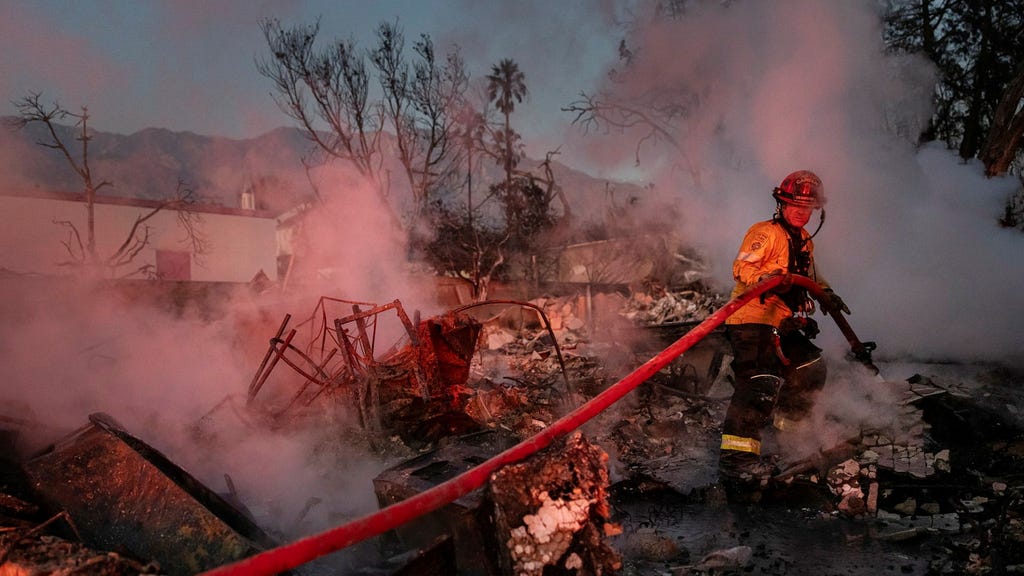The devastating Palisades Fire, which ravaged Los Angeles, likely reignited from a previous fire started by fireworks six days prior, according to a Washington Post investigation. Analyzing photos, satellite imagery, radio communications, and witness testimonies, the Post pinpointed the likely origin of the blaze to the same location where firefighters had previously extinguished a fireworks-related fire along Temescal Ridge in the Santa Monica Mountains. This ”burn scar,” as it’s known, appears to have smoldered underground before flaring up again, tragically igniting the larger Palisades Fire. While the official investigation is ongoing and no formal pronouncements have been made, the Post’s findings suggest a strong link between the two incidents. Michael Gollner, a fire researcher and professor of mechanical engineering at the University of California, Berkeley, corroborated this possibility, stating that it’s entirely feasible for embers from a previous fire to reignite within a week, transitioning from smoldering to flaming combustion. This phenomenon, known as rekindling or holdover fire, can occur when embers remain buried and insulated, retaining heat and eventually igniting dry vegetation. The Post’s meticulous examination of the available evidence provides a compelling narrative of how the Palisades fire likely originated.
The investigation further underscores a concerning trend in recent catastrophic fires, both in California and across the United States. From Colorado to Hawaii, the resurgence of seemingly extinguished fires has contributed significantly to widespread devastation. These instances often involve strong winds, which can fan smoldering embers into roaring flames, rapidly spreading the fire across vast landscapes. In the case of the Palisades fire, strong winds, gusting between 22-30 meters per second, are forecast to persist, further complicating firefighting efforts and threatening to exacerbate the already dire situation. This highlights the critical need for proactive fire management strategies, including thorough suppression and monitoring of fire-prone areas, especially during periods of high winds and dry conditions. The rekindling phenomenon underscores the deceptive nature of seemingly extinguished fires and necessitates a more comprehensive approach to fire management that considers the potential for delayed ignition.
The Palisades fire is just one of many devastating blazes that have recently ravaged California and other parts of the US. These fires, often fueled by dry conditions and strong winds, leave behind a trail of destruction, destroying homes, businesses, and natural habitats. A separate fire, the Eaton Fire, is also under investigation, with authorities exploring a potential link to an electrical facility. The cumulative economic impact of these fires is staggering, with estimated damages from the recent blazes ranging from $60 billion to $130 billion. The human cost is equally devastating, with countless lives disrupted and thousands of homes reduced to ashes. The sheer scale of destruction underscores the urgency of addressing the underlying causes of these fires and implementing effective mitigation strategies.
The repetitive nature of these fire emergencies emphasizes the crucial need for a paradigm shift in fire management practices. This includes not only improved firefighting techniques but also a more proactive approach that focuses on prevention and mitigation. This involves creating defensible spaces around homes, implementing stricter building codes in fire-prone areas, and managing vegetation to reduce fuel loads. Furthermore, understanding the science behind fire behavior, including the phenomenon of rekindling, is crucial for developing more effective suppression and containment strategies. This knowledge can inform better decision-making during firefighting operations, ensuring resources are allocated effectively and minimizing the risk of reignition.
The phenomenon of rekindling, exemplified by the likely cause of the Palisades fire, highlights the importance of thorough mop-up operations following initial fire suppression. Firefighters must ensure that all embers are fully extinguished, not just on the surface but also deep within the ground and within potential fuel sources like logs and debris. This meticulous approach can significantly reduce the risk of reignition, preventing the resurgence of fires that can quickly escalate into major disasters. Moreover, continued monitoring of burn scars, particularly in areas experiencing high winds or dry conditions, is crucial for early detection and rapid response to any signs of rekindling. Deploying thermal imaging cameras and other advanced technologies can help pinpoint hot spots and smoldering embers, enabling firefighters to swiftly address potential threats before they escalate.
The ongoing investigations into the Palisades fire and the Eaton fire underscore the complex interplay of factors that contribute to these catastrophic events. While natural phenomena like dry conditions and strong winds undoubtedly play a role, human actions often serve as the initial spark. The suspected fireworks-related origin of the Palisades fire serves as a stark reminder of the devastating consequences that can arise from carelessness and disregard for fire safety regulations. Similarly, the potential link between the Eaton fire and an electrical facility highlights the importance of maintaining and inspecting critical infrastructure to prevent fire hazards. As communities grapple with the increasing frequency and intensity of wildfires, a multi-faceted approach that addresses both natural and human-induced factors is essential for mitigating the risks and protecting lives and property. This requires a collective effort involving individuals, communities, and government agencies to implement effective fire prevention and management strategies.














